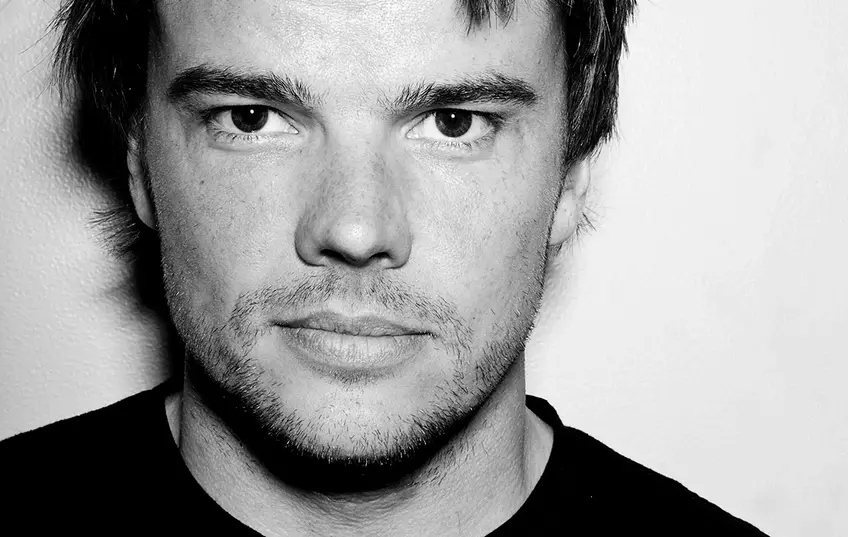 Bjarke Ingels. Photo by Urik Jantzen
Bjarke Ingels. Photo by Urik Jantzen
The term “starchitect” is often a backhanded compliment. Some starchitects, like Frank Gehry for example, loathe the term. There’s a photo circulating of Gehry’s raised middle finger in response to a reporter suggesting that his designs are mere celebrity spectacle rather than functional design. In the National Review, Kevin D. Williamson writes, “The “starchitect” is almost always and everywhere the enemy of the public good, but American public planners … have a terrible weakness for celebrity architects and public grandiosity.”
He aims to be a different type of starchitect, approachable and enthusiastic with the whimsicality of a Dr. Seuss and the verbal acuity of a poet.
In this article:
One of the newest media darlings, Danish architect Bjarke Ingels, may be on the path to changing that perception. Bjarke Ingels has been called “the architect of the moment” by Morley Safer on CBS’s “60 Minutes,” and “the current star of the world’s architectural scene.” Ingels possesses the winning combination of youth, looks, charisma, and a talent both for design and self-marketing. He aims to be a different type of starchitect, approachable and enthusiastic with the whimsicality of a Dr. Seuss and the verbal acuity of a poet. He’s also easy on the eyes, the “McDreamy” of the new guard.
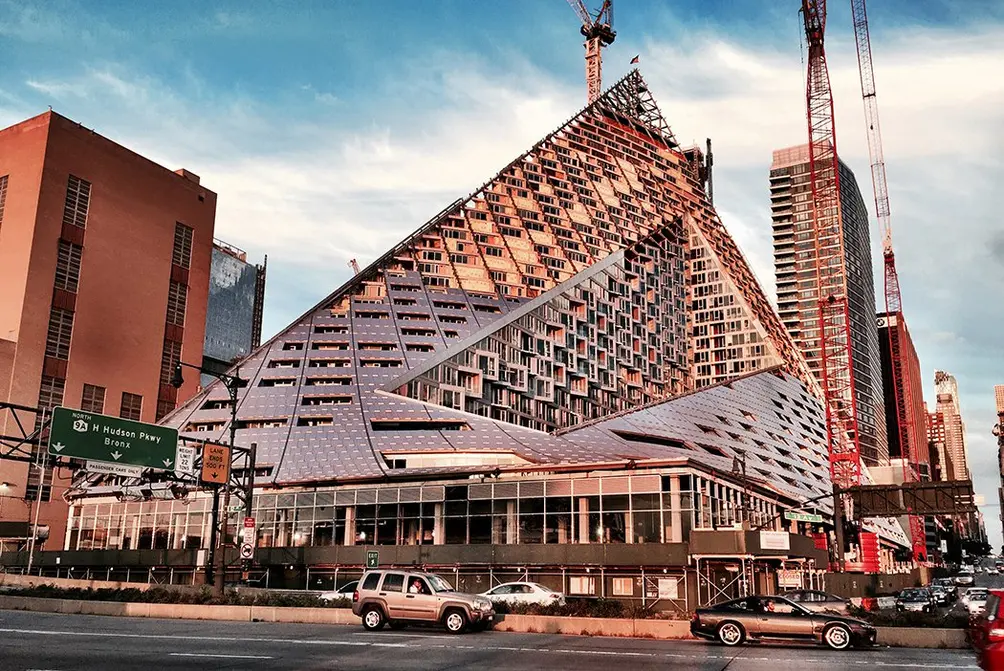 Ingels' VIA located on the West Side along 57th Street
Ingels' VIA located on the West Side along 57th Street
“Coming here to America five years ago, we were given the opportunity to try to reimagine the skyscraper, which is one of the great inventions of American architecture,” Ingels says. At 41, Ingels is surprisingly young for the major projects he’s been landing. Consider his first commission in Manhattan, VIA 57WEST. He burst onto the scene with this sail-shaped, giant tetrahedron of a building on West 57th Street.
“It’s the lovechild of a New York skyscraper and a Copenhagen courtyard building,” Ingels says. “Eventually, we realized that we had to make it much more extreme.”
“It’s the lovechild of a New York skyscraper and a Copenhagen courtyard building,” Ingels says. “Eventually, we realized that we had to make it much more extreme.” It became an asymmetrical tower to the east that drops west toward the river, and the roof became a saddle shape, or what Ingels calls a “hyperbolic paraboloid.” The structure seems to fold in the center to frame a rectangular courtyard, and the apartments overlooking it have expansive views of the Hudson River.
On one side, the building comes to an asymmetrical, pyramidal point. The north and east façade are striated with long terraces cut into the building. To the west, the building leans away from the water, extending the number of windows and terraces with a water view. The façade that frames the courtyard is where Ingels sees the experiment. The cutaway in the center for the courtyard allows apartments that face east to also have western views of the river. Ingels set out to challenge what he refers to as the status quo “formulaic, boring box,” and he did that by throwing out the box altogether. It hovers over the Hudson as if it could lift off and fly at any moment. It’s a dramatic departure from the glass and steel skyscrapers, the Con Edison power plant, and the Department of Sanitation garage that surround it.
On one side, the building comes to an asymmetrical, pyramidal point. The north and east façade are striated with long terraces cut into the building. To the west, the building leans away from the water, extending the number of windows and terraces with a water view. The façade that frames the courtyard is where Ingels sees the experiment. The cutaway in the center for the courtyard allows apartments that face east to also have western views of the river. Ingels set out to challenge what he refers to as the status quo “formulaic, boring box,” and he did that by throwing out the box altogether. It hovers over the Hudson as if it could lift off and fly at any moment. It’s a dramatic departure from the glass and steel skyscrapers, the Con Edison power plant, and the Department of Sanitation garage that surround it.
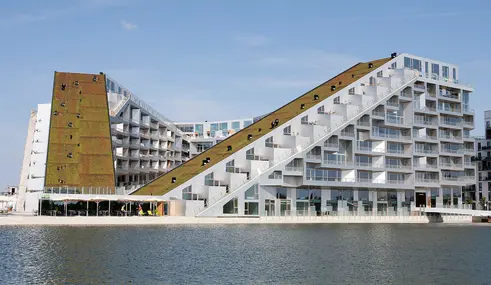 Tallet 8 in Copenhagen, Denmark
Tallet 8 in Copenhagen, Denmark
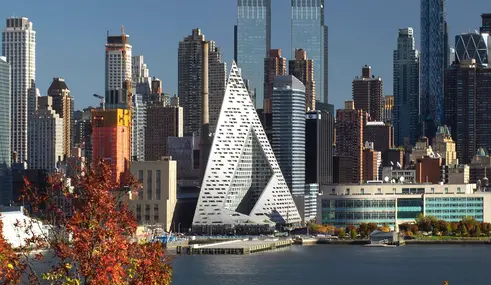 VIA on the waterfront. Image courtesy of BIG
VIA on the waterfront. Image courtesy of BIG
VIA 57WEST evokes another successful design with similar space principles in Ørestad, an area in Copenhagen, Denmark. The 8 House, completed in 2010, is a bow-shaped, mixed-used structure that uses interior courtyards with apartments at the top that take advantage of the views, sunlight, and fresh air, and commercial space at street level.
Bjarke Ingels’ BIG took over the design of 2 World Trade Center from the original architect, Lord Norman Foster, who is literally twice Ingel’s age. Though the foundation for Foster’s design had already been laid, Ingels felt it was “very much designed in the thinking of the old financial district, and as the whole neighborhood has changed, what was needed was a different kind of building.”
He calls the design for 2 World Trade Center “Janus-faced” as the façade facing the Financial District will be totally different from the side facing Tribeca. “It’s at the meeting point of Tribeca, where you have European streetscapes, and the Financial District, where you have the skyscrapers. We thought we could make a building that would fee equally at home in these two neighborhoods.” The resulting plan is stacked cubes that get smaller toward the top on the Tribeca side and a tall, slender shape viewed from the World Trade Center Memorial Plaza. It’s a project that inspires in Ingels both fear and awe.
Bjarke Ingels’ BIG took over the design of 2 World Trade Center from the original architect, Lord Norman Foster, who is literally twice Ingel’s age. Though the foundation for Foster’s design had already been laid, Ingels felt it was “very much designed in the thinking of the old financial district, and as the whole neighborhood has changed, what was needed was a different kind of building.”
He calls the design for 2 World Trade Center “Janus-faced” as the façade facing the Financial District will be totally different from the side facing Tribeca. “It’s at the meeting point of Tribeca, where you have European streetscapes, and the Financial District, where you have the skyscrapers. We thought we could make a building that would fee equally at home in these two neighborhoods.” The resulting plan is stacked cubes that get smaller toward the top on the Tribeca side and a tall, slender shape viewed from the World Trade Center Memorial Plaza. It’s a project that inspires in Ingels both fear and awe.
“I got a letter from a brother of a firefighter that gave his life at the 9/11. He just wrote me to say, ‘I see it as a giant staircase to heaven evoking the heroic stair climb of the first responders at 9/11.’"
“I got a letter from a brother of a firefighter that gave his life at the 9/11,” Ingels recounted to Morley Safter. “He just wrote me to say, ‘I see it as a giant staircase to heaven evoking the heroic stair climb of the first responders at 9/11.’ … He thought the skyline of Manhattan itself would commemorate the heroism and sacrifice of 9/11.” Now, Ingels says, he cannot think of the building without this interpretation. Unfortunately, the building's planned anchor tenant, FOX news, recently pulled out, and it remains unclear how this will affect the design.
Suddenly in great demand, BIG has more than 60 projects coming down the pike in New York City and other places. In Copenhagen, he’s working on the transformation of a waste-to-energy plant where he’s turned the roof into a ski slope, and they hope to incorporate a “steam ring generator” into the smoke stack that will blow massive smoke rings. In New York, BIG got the contract for the Spiral at 66 Hudson Boulevard, a residential project on 126th Street, a police station in the Bronx, the “Escheresque” twisty design of 76 Eleventh Avenue that overlooks the High Line, and the ambitious 10-mile Dryline waterfront park that will serve as a green barrier to protect the city from future flooding. Most recently, BIG revealed a set of the space-age designs for the rehaul of 2 Penn Plaza. Only renderings have been released, and involvement is not yet confirmed.
Suddenly in great demand, BIG has more than 60 projects coming down the pike in New York City and other places. In Copenhagen, he’s working on the transformation of a waste-to-energy plant where he’s turned the roof into a ski slope, and they hope to incorporate a “steam ring generator” into the smoke stack that will blow massive smoke rings. In New York, BIG got the contract for the Spiral at 66 Hudson Boulevard, a residential project on 126th Street, a police station in the Bronx, the “Escheresque” twisty design of 76 Eleventh Avenue that overlooks the High Line, and the ambitious 10-mile Dryline waterfront park that will serve as a green barrier to protect the city from future flooding. Most recently, BIG revealed a set of the space-age designs for the rehaul of 2 Penn Plaza. Only renderings have been released, and involvement is not yet confirmed.
Bjarke Ingels looks at his design as a form a social commentary, and he wants to change the dialogue
Bjarke Ingels looks at his design as a form a social commentary, and he wants to change the dialogue. “If you're just reaffirming the status quo, then you are missing the point that the city is never complete. So every project we do somehow has to count.”

Contributing Writer
Jillian Blume
Jillian Blume is a New York City based writer who has published articles widely in magazines, newspapers, and online. Publications include the New York Observer, Marie Claire, Self, MSN Living, Ocean Home, and Ladies Home Journal. Jillian received a master's degree in Creative Writing from New York University and teaches writing, critical reading, and literature at Berkeley College.

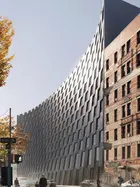
 6sqft delivers the latest on real estate, architecture, and design, straight from New York City.
6sqft delivers the latest on real estate, architecture, and design, straight from New York City.
